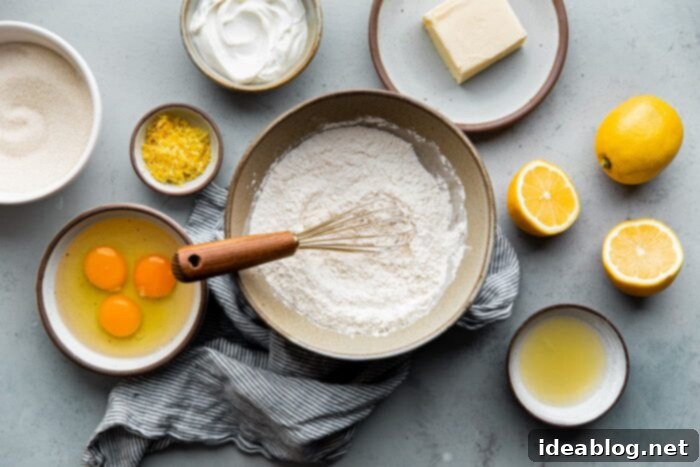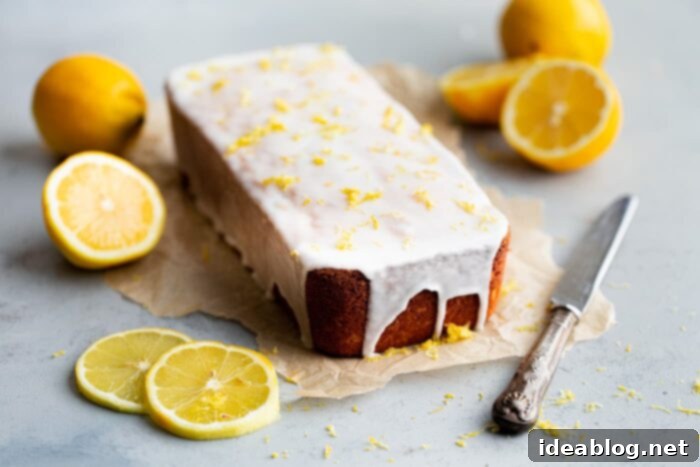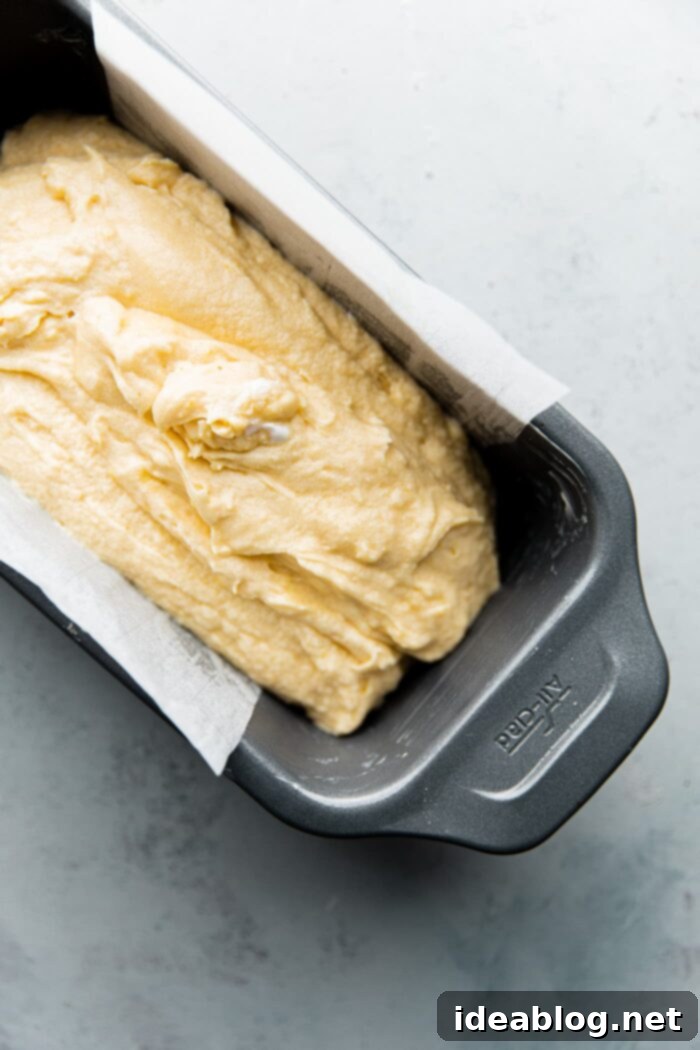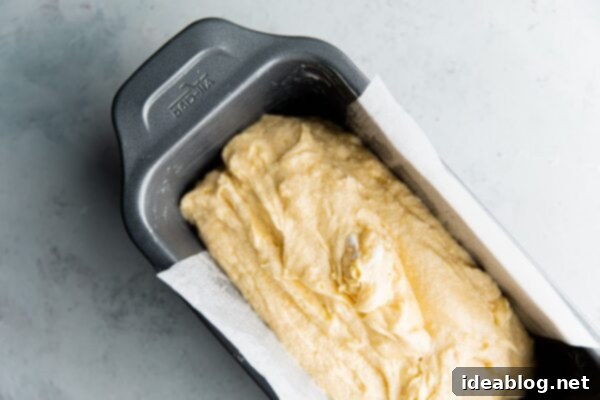The Ultimate Moist Lemon Loaf Cake with Zesty Tart Glaze
Discover the joy of baking with this exquisitely buttery lemon loaf cake, crowned with an irresistible, extra-tart lemon glaze. This simple yet sophisticated cake is a perfect treat for any occasion, from a casual afternoon tea to a special celebration.

As the days grow longer and a hint of warmth returns, there’s no better way to usher in the vibrant spirit of spring than with a slice of this decadent and incredibly moist Lemon Loaf Cake. Forget the lingering chill of winter; this bright, citrus-forward dessert brings sunshine to your table, invigorating your senses with every bite.
If you’re a connoisseur of tangy, aromatic, and deeply flavorful citrus desserts, much like our beloved Orange Bundt Cake with Chocolate Glaze or the elegant Triple Citrus Tart, then this simple yet extraordinary homemade lemon cake is sure to capture your heart. The secret to its unparalleled tenderness and rich texture lies in the generous addition of whole-fat Greek yogurt, which ensures a remarkably moist crumb that melts in your mouth.
This lemon loaf cake strikes the perfect balance between sweet and intensely zesty, truly bursting with the fresh, vibrant flavor of lemons. What truly elevates this dessert is the generous, extra tart lemon glaze. It sets beautifully, forming a delightful crackle with each forkful, delivering an invigorating burst of citrus that is both refreshing and deeply satisfying. This captivating tang is precisely what makes you reach for “just one more” slice.

This lemon loaf cake embodies the essence of an unfussy, versatile dessert. It’s perfectly suited for everyday snacking, brightening up a mundane afternoon, or serving as a delightful centerpiece for any celebration. Its timeless appeal means it can be prepared and savored year-round, though it truly shines during the lighter, brighter months of spring and summer, making it an ideal choice for Easter gatherings or sun-drenched picnics.
The cake’s crumb is wonderfully moist and tender, reminiscent of a classic pound cake but with a slightly lighter, more delicate texture. This balance ensures it’s substantial enough to feel indulgent yet light enough not to overwhelm. It’s truly the best lemon loaf recipe you’ll find, simple to make and always a crowd-pleaser.
While this homemade lemon cake is utterly delicious served plain, allowing its pure lemon flavor to shine, it also welcomes a touch of elegance. Dress it up with generous spoonfuls of freshly whipped cream and a vibrant medley of seasonal mixed berries for a dessert that looks as impressive as it tastes. Whether enjoyed as a simple treat or an elaborate dessert, this moist lemon loaf cake promises pure delight. Happy baking!

Expert Tips for Baking the Perfect Moist Lemon Loaf Cake
Achieving bakery-quality results with this lemon loaf cake is simpler than you think, especially when you follow a few key tips:
- **Room Temperature Ingredients are Non-Negotiable:** As with nearly all baking endeavors, starting with room temperature ingredients is paramount. This includes your butter, eggs, and particularly the whole-fat Greek yogurt. Why is this so crucial? Room temperature ingredients emulsify more effectively, allowing the butter and sugar to cream together properly, incorporating air and creating a light, fluffy base. This, in turn, ensures a consistent, tender, and beautifully crumbed cake.
- **The Creaming Method for a Superior Crumb:** This easy lemon cake recipe, inspired by our popular Lemon Yogurt Pound Cake, skillfully utilizes the creaming method. Combined with small quantities of chemical leaveners (both baking soda and baking powder), this technique builds structure and creates that desirable tender texture.
- **Butter Consistency is Key:** Ensure your unsalted butter is genuinely softened, but steer clear of it being too firm (which won’t cream properly) or too warm/melted (which will result in a greasy, dense cake). The ideal consistency is when it yields slightly when pressed with your finger, leaving a small indentation without feeling oily. This perfect “softened” state allows it to cream beautifully with the sugar.
- **Don’t Overmix the Batter:** Once you start adding the dry ingredients, mix only until they are *just* incorporated. Overmixing develops the gluten in the flour, which can lead to a tough, dry cake. A few streaks of flour are acceptable; you’ll finish mixing by hand with a spatula.
- **Proper Cooling for Best Glaze:** Allow the lemon loaf cake to cool *completely* on a wire rack before applying the tart lemon glaze. If the cake is even slightly warm, the glaze will melt and run off, resulting in a less appealing finish and an uneven distribution of that wonderful zesty flavor.
Why This Lemon Loaf Cake Will Become Your Go-To Recipe
There are countless reasons why this particular lemon loaf cake recipe stands out and is destined to become a cherished favorite in your recipe collection:
- **Effortless Baking, Exceptional Results:** You’ll love its remarkably simple ingredient list, requiring no specialty baking equipment beyond a standard 8 x 4-inch (20 x 10 cm) loaf pan. This makes it an accessible recipe for bakers of all skill levels, delivering impressive results without any fuss.
- **A Symphony of Texture and Flavor:** This recipe consistently yields a beautifully buttery, rich, and tender cake that is suitable for both everyday indulgence and momentous special occasions. Its balanced sweetness and bright lemon flavor make it universally appealing.
- **Unapologetically Lemon-Forward:** This cake does not skimp on authentic lemon flavor! It features a generous addition of both fresh lemon juice and vibrant lemon zest in the batter. The truly extra tart lemon glaze is the crowning glory, adding a burst of intense citrus that makes this moist lemon loaf cake truly shine and sing. It’s a lemon lover’s dream come true.
- **Versatility at Its Best:** Whether you’re craving a sweet breakfast treat, a delightful addition to your brunch spread, or a satisfying afternoon pick-me-up with your coffee or tea, this cake fits every bill. It’s robust enough to travel well for potlucks and elegant enough to serve as a dessert.
- **The Perfect Partner for Any Beverage:** The bright, refreshing notes of this cake pair wonderfully with a hot cup of tea, a bold coffee, or even a glass of sparkling wine, making it a sophisticated choice for any time of day.

Creative Flavor Variation Ideas for Your Loaf Cake:
While this lemon loaf cake is spectacular as is, don’t hesitate to experiment with different citrus notes to create your own unique twist. You can easily substitute the lemon juice and zest with other bright citrus varieties, such as fragrant lime, sweet orange or exotic blood orange, or even slightly bitter grapefruit. A delightful combination of several citrus fruits can also yield a beautifully complex flavor profile.
Once your exquisite glaze has set, consider adding an extra layer of visual appeal and texture. Garnish the top of your cake with finely crushed pistachios for a lovely green pop and nutty crunch, or sprinkle toasted almond slices for a warm, inviting aroma and delicate crispness. These additions not only enhance the aesthetic but also provide a delightful contrast to the smooth, tart glaze, taking your homemade lemon cake to the next level.

How to Properly Store Your Delicious Lemon Loaf Cake:
To enjoy this moist lemon loaf cake at its absolute peak, it is best served the day it is baked, or the very next day. Its freshness and vibrant flavor are most pronounced during this time.
Should you find yourself with delightful leftovers, fear not! This cake stores wonderfully. Simply wrap the remaining slices or the entire loaf tightly in plastic wrap to prevent it from drying out, and store it at room temperature. It will maintain its delicious taste and moist texture for 2 to 3 days.
For longer preservation, this lemon cake also freezes and thaws incredibly well, making it perfect for meal prep or enjoying a taste of summer lemon goodness anytime. If you plan to freeze it, be sure to skip applying the glaze initially. Once the baked loaf cake has cooled completely, wrap it very tightly in several layers of plastic wrap, ensuring no air can get in. Then, cover it with a layer of aluminum foil for extra protection against freezer burn. Place the double-wrapped loaf into a large freezer-safe Ziplock bag, removing as much air as possible, and freeze for up to 2 to 3 months.
When you’re ready to enjoy your frozen lemon loaf, transfer it (still covered) to your countertop and allow it to thaw gradually at room temperature for 12 to 24 hours. Once fully thawed, you can then prepare and apply the tart lemon glaze fresh, just before serving. This method ensures that your thawed cake tastes just as fresh and delicious as the day it was baked, complete with its bright, zesty topping.

Lemon Loaf Cake
Pin
Review
Save
Saved!
8
– 10 Servings (One 8 x 4-inch Loaf Cake)
15 minutes
55 minutes
1 hour
10 minutes
Equipment
-
All-Clad Nonstick Pro-Release Loaf Pan
-
KitchenAid 5 Qt. Artisan Stand Mixer
Ingredients
-
1⅓
cups (160g)
unbleached all-purpose flour
fluffed, spooned, and leveled -
½
teaspoon
kosher salt -
¼
teaspoon
baking soda -
¼
teaspoon
baking powder -
1¼
cups (250g)
granulated sugar -
1
tablespoon
fresh lemon zest
roughly 1-2 lemons -
4
ounces (115g; 8 tablespoons)
unsalted butter
softened -
2
tablespoons (30 mL)
fresh lemon juice -
1
teaspoon
pure vanilla extract
optional -
3
large
eggs
room temperature -
½
cup (113g)
whole fat Greek yogurt
room temperature
Lemon Glaze:
-
1
cup (120g)
powdered sugar
sifted -
2
tablespoons (30 mL)
fresh lemon juice -
finely grated lemon zest
for decorating
Instructions
-
Prepare Lemon Loaf Cake: Preheat the oven to 325°F (160°C) with a rack in the center position. Lightly grease a 8 x 4-inch (20 x 10 cm) loaf pan. For easy removal, line the pan with parchment paper, leaving an overhang on the longer sides. Set aside.
-
In a small mixing bowl, whisk together the unbleached all-purpose flour, kosher salt, baking soda, and baking powder. This ensures the leaveners are evenly distributed for a consistent rise. Set aside.

-
In the bowl of a stand mixer, combine the granulated sugar and fresh lemon zest. Using your fingertips, rub the sugar and lemon zest together until the sugar is moist and fragrant. This process extracts the essential oils from the zest, infusing the sugar with intense lemon flavor. Add the softened unsalted butter. Using the paddle attachment, beat the butter and sugar mixture at medium speed for 4 to 5 minutes, or until it becomes light, fluffy, and pale yellow. Next, add the fresh lemon juice and vanilla extract (if using) and beat until fully incorporated. Over medium speed, slowly add the large eggs, one at a time, beating well after each addition until each egg is completely incorporated into the mixture. If the batter appears to break slightly or look curdled as you add more eggs, don’t worry—this is normal and it will come back together once we add the flour mixture. Scrape down the sides and bottom of the bowl once or twice with a rubber spatula to ensure all of the ingredients are incorporated evenly.
-
Reduce the mixer speed to low. Slowly add the whisked flour mixture in three additions, alternating with two additions of the room temperature whole fat Greek yogurt. Begin and end with the flour mixture. Mix only until the flour has just been absorbed and no dry streaks remain. It is crucial not to overmix at this stage, as it can lead to a tough cake. Remove the bowl from the mixer and, using a spatula, gently scrape down the sides and bottom of the bowl to ensure all ingredients are evenly incorporated and the batter is smooth.
-
Carefully transfer the prepared batter to the greased and parchment-lined loaf pan. Using an offset spatula or the back of a spoon, gently spread the batter into an even, smooth layer, ensuring it reaches all corners of the pan. Bake for 50 to 60 minutes, or until a wooden skewer or cake tester inserted into the center of the loaf comes out clean. The cake should be beautifully golden brown on top and just beginning to slightly pull away from the edges of the pan. Once baked, set the pan on a wire rack and allow the cake to cool in the pan for 5 to 7 minutes. This allows the cake to firm up slightly. Then, using the parchment paper overhang, carefully lift the cake from the pan and transfer it to the wire rack to cool completely. This step is essential before decorating with the glaze.

-
Prepare Lemon Glaze: While the cake cools, prepare your vibrant lemon glaze. In a medium bowl, whisk together the sifted powdered sugar and fresh lemon juice until smooth and thick, yet still able to be drizzled easily from a spoon. If the glaze is too thin, whisk in a touch more sifted powdered sugar, a teaspoon at a time. If it’s too thick, add a few more drops of lemon juice until the desired consistency is reached. For quick and easy clean-up, place the completely cooled loaf cake on a wire rack set within a rimmed baking sheet (this catches any drips). Spoon the prepared glaze evenly over the top of the cake, allowing it to artfully fall slightly over the edges. For a final flourish and extra lemon punch, decorate with freshly grated lemon zest. Allow the glaze to set for 5 to 10 minutes before slicing and serving your delicious lemon loaf cake.
-
This cake is truly at its best the day it is baked or the day after. Leftovers can be wrapped tightly in plastic wrap and stored at room temperature for 2 to 3 days, maintaining its wonderful moistness.
-
Freezing Instructions: To enjoy this delightful lemon loaf at a later date, it freezes beautifully. If you wish to prep this recipe ahead, skip the glaze application. Once the cake has cooled completely, wrap the loaf tightly in several layers of plastic wrap, then cover it with aluminum foil. Place the well-wrapped loaf in a freezer-safe Ziplock bag and freeze for up to 2 to 3 months. When ready to serve, allow the cake to thaw (still covered) at room temperature for 24 hours. Once thawed, prepare and apply the fresh lemon glaze as per step 5, then decorate and serve.
Flavor Variation Ideas:
- Unleash your creativity by substituting the lemon juice and zest with other delightful citrus varieties, such as vibrant lime, sweet orange, striking blood orange, or subtly bitter grapefruit. You can even combine several for a more complex and intriguing flavor profile.
- For an added layer of texture and visual appeal, just after glazing, garnish the top of the cake with finely crushed pistachios (for a beautiful green hue and nutty crunch) or delicately toasted almond slices (for warmth and a subtle crispness). These additions perfectly complement the tart glaze and moist crumb.
Adapted from my beloved Lemon Yogurt Pound Cake, this recipe delivers a wonderfully moist and flavorful experience.
Serving:
1
serving
,
Calories:
541
kcal
,
Carbohydrates:
98
g
,
Protein:
8
g
,
Fat:
14
g
,
Saturated Fat:
8
g
,
Polyunsaturated Fat:
1
g
,
Monounsaturated Fat:
4
g
,
Trans Fat:
1
g
,
Cholesterol:
101
mg
,
Sodium:
228
mg
,
Potassium:
103
mg
,
Fiber:
1
g
,
Sugar:
67
g
,
Vitamin A:
458
IU
,
Vitamin C:
4
mg
,
Calcium:
46
mg
,
Iron:
2
mg
Cakes and Cupcakes
American




